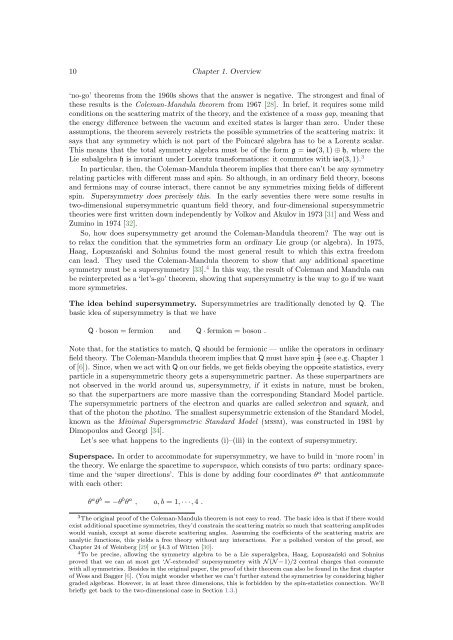The Bethe/Gauge Correspondence
The Bethe/Gauge Correspondence
The Bethe/Gauge Correspondence
You also want an ePaper? Increase the reach of your titles
YUMPU automatically turns print PDFs into web optimized ePapers that Google loves.
10 Chapter 1. Overview‘no-go’ theorems from the 1960s shows that the answer is negative. <strong>The</strong> strongest and final ofthese results is the Coleman-Mandula theorem from 1967 [28]. In brief, it requires some mildconditions on the scattering matrix of the theory, and the existence of a mass gap, meaning thatthe energy difference between the vacuum and excited states is larger than zero. Under theseassumptions, the theorem severely restricts the possible symmetries of the scattering matrix: itsays that any symmetry which is not part of the Poincaré algebra has to be a Lorentz scalar.This means that the total symmetry algebra must be of the form g = iso(3, 1) ⊕ h, where theLie subalgebra h is invariant under Lorentz transformations: it commutes with iso(3, 1). 3In particular, then, the Coleman-Mandula theorem implies that there can’t be any symmetryrelating particles with different mass and spin. So although, in an ordinary field theory, bosonsand fermions may of course interact, there cannot be any symmetries mixing fields of differentspin. Supersymmetry does precisely this. In the early seventies there were some results intwo-dimensional supersymmetric quantum field theory, and four-dimensional supersymmetrictheories were first written down independently by Volkov and Akulov in 1973 [31] and Wess andZumino in 1974 [32].So, how does supersymmetry get around the Coleman-Mandula theorem? <strong>The</strong> way out isto relax the condition that the symmetries form an ordinary Lie group (or algebra). In 1975,Haag, ̷Lopuszański and Sohnius found the most general result to which this extra freedomcan lead. <strong>The</strong>y used the Coleman-Mandula theorem to show that any additional spacetimesymmetry must be a supersymmetry [33]. 4 In this way, the result of Coleman and Mandula canbe reinterpreted as a ‘let’s-go’ theorem, showing that supersymmetry is the way to go if we wantmore symmetries.<strong>The</strong> idea behind supersymmetry. Supersymmetries are traditionally denoted by Q. <strong>The</strong>basic idea of supersymmetry is that we haveQ · boson = fermion and Q · fermion = boson .Note that, for the statistics to match, Q should be fermionic — unlike the operators in ordinaryfield theory. <strong>The</strong> Coleman-Mandula theorem implies that Q must have spin 1 2(see e.g. Chapter 1of [6]). Since, when we act with Q on our fields, we get fields obeying the opposite statistics, everyparticle in a supersymmetric theory gets a supersymmetric partner. As these superpartners arenot observed in the world around us, supersymmetry, if it exists in nature, must be broken,so that the superpartners are more massive than the corresponding Standard Model particle.<strong>The</strong> supersymmetric partners of the electron and quarks are called selectron and squark, andthat of the photon the photino. <strong>The</strong> smallest supersymmetric extension of the Standard Model,known as the Minimal Supersymmetric Standard Model (mssm), was constructed in 1981 byDimopoulos and Georgi [34].Let’s see what happens to the ingredients (i)–(iii) in the context of supersymmetry.Superspace. In order to accommodate for supersymmetry, we have to build in ‘more room’ inthe theory. We enlarge the spacetime to superspace, which consists of two parts: ordinary spacetimeand the ‘super directions’. This is done by adding four coordinates θ a that anticommutewith each other:θ a θ b = −θ b θ a , a, b = 1, · · ·, 4 .3 <strong>The</strong> original proof of the Coleman-Mandula theorem is not easy to read. <strong>The</strong> basic idea is that if there wouldexist additional spacetime symmetries, they’d constrain the scattering matrix so much that scattering amplitudeswould vanish, except at some discrete scattering angles. Assuming the coefficients of the scattering matrix areanalytic functions, this yields a free theory without any interactions. For a polished version of the proof, seeChapter 24 of Weinberg [29] or §4.3 of Witten [30].4 To be precise, allowing the symmetry algebra to be a Lie superalgebra, Haag, ̷Lopuszański and Sohniusproved that we can at most get ‘N -extended’ supersymmetry with N (N −1)/2 central charges that commutewith all symmetries. Besides in the original paper, the proof of their theorem can also be found in the first chapterof Wess and Bagger [6]. (You might wonder whether we can’t further extend the symmetries by considering highergraded algebras. However, in at least three dimensions, this is forbidden by the spin-statistics connection. We’llbriefly get back to the two-dimensional case in Section 1.3.)
















